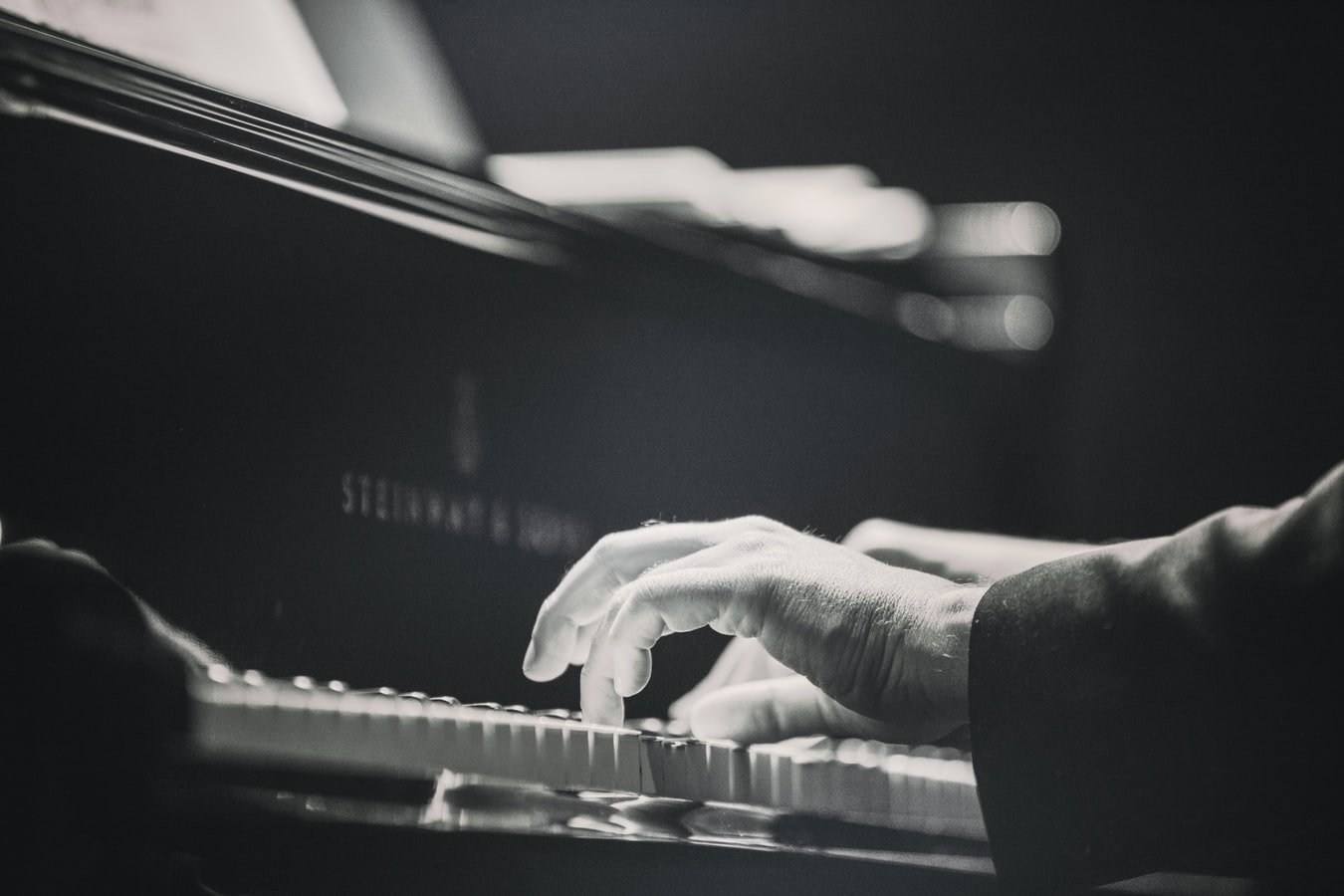The piano is a pretty unique instrument when you consider the fact that it covers a huge range of notes. Hit the keys furthest to the left and you will get an incredibly deep sound. Hit the keys to the right and you’ll get a high-end “tinkle”.
The sound that a piano can produce is amazing, and bass notes on piano give you the ability to create a rich and expressive sound. So, how do bass notes work? What is the key to understanding the bass clef in written music and how can you learn to play bass notes with your left hand while you play melody or chords with the right?
We’ve put together a full guide to bass notes on piano here to help you to understand and start learning, along with the lessons within the Pianu Academy.
What Are Bass Notes on Piano?
Let’s start with the most basic of information relating to what bass notes actually are. Bass notes can be described as those that are played on the bass clef. This covers all of the notes below middle C. When reading music, you will see the bass clef symbolized by what looks like a curly, old-fashioned letter on the staff.
This doesn’t necessarily give you the full picture. It may help to use other instruments to consider the notes, and to understand octaves on the piano.
Each set of octaves contains eight white notes. There are a total of seven octaves on a full-sized piano, which has 88 keys. In the simplest terms, the furthest octave to the left will have the lowest sound, gradually getting higher. You are playing the same notes, but a B2 (signified with “2” because it is played on the second octave) is lower than a B6.
Think about a bass guitar, or even a bassoon. The notes being played on these instruments are closer to the left. They cover more of the bass frequencies. If you then consider another instrument by comparison, like the piccolo or certain types of horn, you’ll hear a difference. These instruments tend to exist in the higher frequencies.
As explained before, the piano is in a very select category when you consider that it can cover so many frequencies and has a huge range of pitches. Seven full octaves really is an impressive range, rivalled only by a few other instruments like a harp.
Why We Play Bass Notes on Piano
It helps to consider the comparison with guitar music. If you see a standard band setup, there may be three different types of guitar being played.
For example, a bass guitar may be covering the lower notes. An acoustic guitar may cover some of the middle frequencies and give a rhythm to the song in question. A lead guitar then may be playing a riff a little higher up. These rules aren’t set in stone, there are lots of ways to play songs.
When you play piano, the difference is that you can play more at the same time. Whereas a guitar needs both your hands to create a smaller range of notes and sounds, the piano doesn’t. By playing with both left and right hand at the same time you can create a huge and interesting sound, or a subtle nuanced sound. It all depends what you’re looking for.
So, it could be that you play bass notes with the left hand, and chords with the right. Alternatively, you might be playing bass notes on piano with your left hand and a melody on the right. You might be changing things up as the song goes on. This allows you to do far more with the piano than many other instruments. Think of an amazing concert pianist and the skill that they can show by sitting at a piano playing incredibly detailed songs. This goes to show what an impact playing bass notes can have.
While there are some special techniques that can be used to replicate piano pieces on other instruments (check out the video below) this is not the norm. It also doesn’t provide the same sort of depth and range of a piano.
Piano Pieces Played On Bass
In summary, playing bass notes has the following effect:
- Increases your skill as a pianist.
- Enables you to play much more complex songs with a wider range.
- Lets you emulate some of the piano greats.
- Helps you to gain an understanding of composition and performance.
The comparison with other instruments is very valid and interesting, and goes to show that piano is a great choice. Few instruments let you achieve so much in terms of impressive sound.
How to Read the Bass Clef
If you are going to take the traditional approach to piano, you will be learning how to read music. With the Pianu academy, it is easier than ever to understand how the symbols on the screen (or paper) relate to your actions. You should try to understand the bass clef as one of the foundational pieces of knowledge.
As you may have already worked out, this relates to the notes you will be playing with your left hand. This is the same whether you are left-handed or right-handed. Piano is not like the guitar, which has different models for left and right-handed players.
The bass clef is similar to the treble clef when you look at it. The stave system that indicates which notes you should be playing has a system of lines and spaces. The note symbol can either be right on the line, or sit between the line in the spaces.
Middle C, for example, is a line note. This sits on a line when you read the music. Of course, this means that the note one below (B) is a space note, sitting in between lines.
Bass Clef Mnemonics
To learn the notes of the bass clef, a lot of people use a device called a mnemonic. This is a pattern of letters or a literary device that helps you to understand what the notes are. For instance, one of the popular ways to remember the notes on a guitar is “Eddie Ate Dynamite, Good Bye Eddie” which tells you the notes are E A D G B E.
There are similar patterns for the notes of the bass clef. “Green Buses Drive Fast Always” tells us the notes, from the bottom of the clef to the top. G B D F A. This applies to the notes that are on the line.
For the space notes, another simple mnemonic: “All Cows Eat Grass” tells us the notes are A C E G.
Once you have found the notes, a lot of people find it much easier to learn how to play a melody by working out the spaces between one note and the next. The first note acts as your anchor, and you can then work out the difference in semitones between this and the next note. The visual intervals help you a great deal here.
Tips For Learning Bass Notes
One of the biggest challenges you are likely to come across is learning how to use both of your hands at once. The way Piano has designed the Academy can help a great deal. You can gradually learn how to play notes on both the left hand and the right hand before you combine the two. Remember, the left hand is always where the bass notes are going to be played.
There are a lot of different challenges to overcome when learning the piano. The biggest challenge with piano bass notes is getting used to playing with two hands at the same time.
The following tips can really help you to learn more easily:
- Practise with one hand at a time. There is really no point in trying to play with both hands at the same time. This will feel like trying to write a novel with your left hand and draw a beautiful picture with your right. With time, you can get better at it, but you must learn the foundations. This means one hand at a time. This applies whether your left hand is playing chords or bass notes.
- Learn slowly. With Pianu academy you can learn at your own pace. All too often when people start to learn how to play the piano they think they can do it at the speed of the song in question. This is almost never possible for a beginner, nor is it necessary. When you first start, take your time. It is far better to be able to play a tune a little slower than not at all. Over time, you can build up the level and speed you’re playing at.
- Use your eyes and ears as much as your hands. It is tempting to jump in and start playing. The truth is that there are a lot of ways you should familiarize yourself with the song before you do this. Listening clearly to the bass parts, as well as looking at the sheet music in detail, are ways to make sure you are playing correctly.
- Don’t overdo it. Sometimes people play for hours and hours a day to try and get the technique perfected. This is fine, if you are mentally prepared to do this, but that is not usually the case for many of us. Playing too much can be a way to lose interest.
Types of Bass Line on Piano
You should try and wrap your head around bass lines first. What are they? How do they work? Well, luckily, there are only a few different basic types of bass line. It helps to practise these when you are trying to build a fundamental knowledge of the piano. We all know that rules are there to be broken. Not every piano bass line fits into one of these categories, but most do.
Let’s explore the types of bass line on piano.
Root Notes
This is an excellent place to start when you are learning how to play the piano. The root note is just the first note of a chord. By playing chords on your right hand (or melodies) and a simple root note, you can thicken the sound.
For instance, if you play a chord sequence that goes “F, Am, C, G” then your root notes will be the first note of each chord. The chords are playing in your right hand, and your left hand simply follows the chord changes, playing F, A, C, G.
If you are an absolute beginner, start here. Even while you play a simple melody, it is possible to play the root notes on your left hand at the same time. You will be amazed at the difference it makes having some bass notes in there.
Eventually, you can focus on things like rhythm. Root notes can be played in many different styles and rhythms, but initially, just concentrate on the piano bass notes.
Arpeggio
Arpeggios are when you cycle through the notes within a scale. This forms a type of melody. This video will show you some famous examples of arpeggios that are used in very famous songs. It also helps with the specific fingering required for playing quick arpeggios.
Often, arpeggios are just cycling through the three notes that make up a chord. This provides more of a rhythm in the track and a bit more interest than simply playing root notes. Of course, there are different speeds in which you can play the arpeggio. Advanced pianists get to the point where they can play arpeggios quickly on both left and right hands. This means that it can form a part of the bass notes played in a classical piece or a pop piece.
Walking Bass Lines
Walking bass lines are associated with some kinds of music. You may have heard walking bass notes without noticing it.
“A walking bass is a style of bass accompaniment or line, common in Baroque music (1600–1750) and 20th century jazz, blues and rockabilly, which creates a feeling of regular quarter note movement, akin to the regular alternation of feet while walking” – Buelow, George J. (2004), A history of baroque music.
Usually, a walking bass note is a combination of quarter notes. The notes move around the scale, and give the feeling of regular movement that reminds people of “walking”. Hence the name. Check out the video below for a great example of walking bass.
There are many different ways to play walking bass lines. They are a good part of the fundamental knowledge you can build. If you want to play jazz music or certain other styles, walking bass might form a big part of your arsenal of skills.
Left Hand Exercises For Piano
The left hand is the one that will be doing the hard work when it comes to playing the bass notes. The majority of the population are right handed, but if you are going to become a pianist then you are going to have to be able to use both.
There are some great exercises that can be used to improve your piano technique.
Practise Scales, Arpeggios, and Fundamentals on Both Hands
Though there are certain types of playing you are more likely to come across with your left hand, the same skills will be needed for both. The better understanding you have of playing through the scales and arpeggios with both hands, the better. Learning how to play the same patterns on both hands can act as an exercise to improve your skills. This is a good way to build up your knowledge. This isn’t like playing soccer where you can often avoid the use of the foot you don’t want to use, you need to be able to play with both left and right hands.
Mirror Your Left and Right Hands
Building your dextrous abilities involves using both left and right hands, and being able to mirror what both are doing. For example, you can run through scales on both hands. You might be able to first do the right hand and then the left, or vice versa. Closely monitoring how your skills translate from one hand to another makes all the difference. Your hands should stay flexible but your fingers making firm contact with the keys.
This is all about coordination and the relationship between brain and hands, and it is not easy. You should spend some time on this to make sure you have the right level of hand-eye coordination. It can take years to get to the level you need, so don’t be disheartened.
Play More Firmly On Your Left Hand
The keys on the left of the piano might need to be struck more firmly to generate the same level of power in the sound. If you want to hear the melody you are playing clearly then a firm touch may make all the difference. This lets you hear if you are making a mistake.
One of the difficult things about learning how to play the piano is not being able to get feedback when playing alone. Pianu sets out to rectify this. Our Academy can provide you with real-time analysis of your playing.
Play the Same Bass Line Higher Up
Sometimes, moving the bass line up an octave or two can also help you to hear more clearly. This is a way to gain a bit more clarity and get used to playing at a different octave, too.
You don’t need to do anything special here. Just learn how to play the bass line, and then move your playing to the right one or two octaves and see how it sounds. Ensure that you are still using your left hand to play the melody.
Conclusion – Playing Bass Notes on Piano
When you learn how to play the piano, you simply have to be able to use both the left and right hand. While you can practise them both separately, eventually, you’re going to have to combine them. This is one of the hardest things for beginners.
The bass notes on the left hand are absolutely crucial. Learning about the bass clef and the notes that are included, and how they relate to your left hand, can be done in some of the earlier lessons of the Pianu Academy.
Bass notes give your playing range and help it to sound intricate as well as detailed. This step is one of the most rewarding to get right as it turns your playing into a much more professional end result.
FAQs
What are bass and treble notes?
The bass clef (also known as the F clef) is where the lower bass notes are situated. These notes are played on the lower octaves with the left hand. The treble clef is where the higher notes are played, usually with the right hand. Both have a musical staff to learn and get to grips with.
Is Middle C bass or treble?
Middle C gets its name from where it is situated; precisely in the middle. On the grand staff, encompassing all of the notes, it would be right in the center. This means that it is above the bass clef and below the treble. It marks the middle of the keyboard and is an important musical tool.
What is the bass vocal range on piano?
If you want to use the bass notes to find the pitch for bass vocals, these are usually situated between D2 and E4. This is the range we would know as bass when it comes to choral singing, for instance.
How do you memorize bass clef notes on piano?
The mnemonics vary, but a lot of people use “Green Buses Drive Fast Always” or even “Good Boys Do Fine Always” to indicate the notes on the lines (G B D F A), and “All Cows Eat Grass” is used for the notes on the lines, A, C, E, G.











